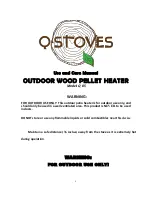
8
Flue pipes with a smaller cross-sectional area
than that of the stove outlet should never
be used. Flue pipes must not project into
the chimney connector, such as to cause a
restriction to the gas flow.
Consideration must be given to installing
extra access in the flue system to ensure all
sections can be cleaned and maintained.
FUME EMISSIONS
To avoid chimney problems, your fire should
not be burnt slowly for longer than 12 hours
without a period of fast burning.
Properly installed and operated, this stove will
not emit fumes. Occasional fumes from de-
ashing and refueling may occur. Persistent
fume emission must not be tolerated. If fume
emission persists, the following immediate
action should be taken:
1. Open doors and windows to ventilate
room.
2. Let the fire out, or eject and safely dispose
of fuel from the stove.
3. Check for flue chimney blockage and
clean if required.
4. Do not attempt to re-light the fire until the
cause has been identified and corrected.
If necessary, seek professional advise
6. OPERATING INSTRUCTIONS
THE CONTROLS
The amount of heat emitted by the stove is
regulated using the air control built at front
of the stove.
Using primary air when burning mineral
fuel and secondary air when burning wood.
The need for de-ashing the appliance more
frequently when burning mineral fuel.
By adjusting the degree to which the
primary air and air-wash vents are opened,
good control of the combustion is being
established.
The “air-wash” feature when used, should
function to effectively keep the inside of the
door glass clear of smokey deposits.
WARNING:
The temperature reached by these items
during operation may cause an injury to an
end-user.
As these are intended to be adjusted during
operation, it is recommended that protective
gloves are worn when handing these parts.
FUEL
This stove will function with wood or
manufactured smokeless fuel, but in general
all fuel should be dry and timber should
be well seasoned so as to have a moisture
content below 20%.
The use of damp wood will result in more soot
and tar deposits being left in the chimey, flue
and stove, and will not release heat if thermal
energy is being used to drive out moisture
from the fuel.
DO NOT BURN wet or unseasoned wood,
construction timber, painted or treated
wood, driftwood or manufactured board
products.
Doing so will result in the wood burning
inefficiently and excess smoke, soot and tar
will be produced.
This will coat and damage the internal
components of the stove and flue and could
result in a chimney fire.
Primary air
control
Secondary air
control


































